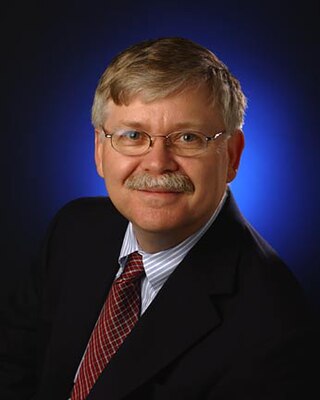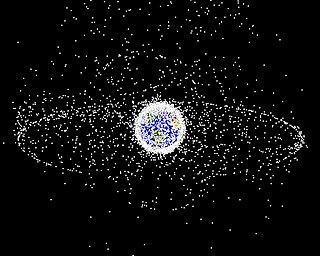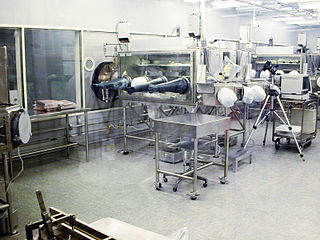Related Research Articles

Extraterrestrial life, alien life, or colloquially simply aliens is life which does not originate from Earth. No extraterrestrial life has yet been conclusively detected. Such life might range from simple forms such as prokaryotes to intelligent beings, possibly bringing forth civilizations that might be far more advanced than humanity. The Drake equation speculates about the existence of sapient life elsewhere in the universe. The science of extraterrestrial life is known as astrobiology.
The search for extraterrestrial intelligence (SETI) is a collective term for scientific searches for intelligent extraterrestrial life, for example, monitoring electromagnetic radiation for signs of transmissions from civilizations on other planets.

Space colonization is the use of outer space or celestial bodies other than Earth for permanent habitation or as extraterrestrial territory.

Terraforming or terraformation ("Earth-shaping") is the hypothetical process of deliberately modifying the atmosphere, temperature, surface topography or ecology of a planet, moon, or other body to be similar to the environment of Earth to make it habitable for humans to live on.

The SETI Institute is a not-for-profit research organization incorporated in 1984 whose mission is to explore, understand, and explain the origin and nature of life in the universe, and to use this knowledge to inspire and guide present and future generations, sharing knowledge with the public, the press, and the government. SETI stands for the "search for extraterrestrial intelligence".

Space law is the body of law governing space-related activities, encompassing both international and domestic agreements, rules, and principles. Parameters of space law include space exploration, liability for damage, weapons use, rescue efforts, environmental preservation, information sharing, new technologies, and ethics. Other fields of law, such as administrative law, intellectual property law, arms control law, insurance law, environmental law, criminal law, and commercial law, are also integrated within the space law.
Xenoarchaeology, a branch of xenology dealing with extraterrestrial cultures, is a hypothetical form of archaeology that exists mainly in works of science fiction. The field is concerned with the study of the material remains to reconstruct and interpret past life-ways of alien civilizations. Xenoarchaeology is not currently practiced by mainstream archaeologists due to the current lack of any material for the discipline to study.
The zoo hypothesis speculates on the assumed behavior and existence of technologically advanced extraterrestrial life and the reasons they refrain from contacting Earth. It is one of many theoretical explanations for the Fermi paradox. The hypothesis states that alien life intentionally avoids communication with Earth to allow for natural evolution and sociocultural development, and avoiding interplanetary contamination, similar to people observing animals at a zoo. The hypothesis seeks to explain the apparent absence of extraterrestrial life despite its generally accepted plausibility and hence the reasonable expectation of its existence. A variant on the zoo hypothesis suggested by the former MIT Haystack Observatory scientist John Allen Ball is the "laboratory" hypothesis, in which humanity is being subjected to experiments, with Earth serving as a giant laboratory.

Planetary protection is a guiding principle in the design of an interplanetary mission, aiming to prevent biological contamination of both the target celestial body and the Earth in the case of sample-return missions. Planetary protection reflects both the unknown nature of the space environment and the desire of the scientific community to preserve the pristine nature of celestial bodies until they can be studied in detail.

Extraterrestrial real estate refers to claims of land ownership on other planets, natural satellites, or parts of space by certain organizations or individuals. Previous claims are not recognized by any authority, and have no legal standing. Nevertheless, some private individuals and organizations have claimed ownership of celestial bodies, such as the Moon, and are actively involved in "selling" parts of them through certificates of ownership termed "Lunar deeds", "Martian deeds" or similar.

A sample-return mission is a spacecraft mission to collect and return samples from an extraterrestrial location to Earth for analysis. Sample-return missions may bring back merely atoms and molecules or a deposit of complex compounds such as loose material and rocks. These samples may be obtained in a number of ways, such as soil and rock excavation or a collector array used for capturing particles of solar wind or cometary debris. Nonetheless, concerns have been raised that the return of such samples to planet Earth may endanger Earth itself.
The ethics of terraforming has constituted a philosophical debate within biology, ecology, and environmental ethics as to whether terraforming other worlds is an ethical endeavor.
Active SETI is the attempt to send messages to intelligent extraterrestrial life. Active SETI messages are predominantly sent in the form of radio signals. Physical messages like that of the Pioneer plaque may also be considered an active SETI message. Active SETI is also known as METI.

Steven J. Dick is an American astronomer, author, and historian of science most noted for his work in the field of astrobiology. Dick served as the chief historian for the National Aeronautics and Space Administration from 2003 to 2009 and as the Baruch S. Blumberg NASA/Library of Congress Chair in Astrobiology from 2013 to 2014. Before that, he was an astronomer and historian of science at the United States Naval Observatory in Washington, DC, from 1979 to 2003.

Humans have been present in space either, in the common sense, through their direct presence and activity like human spaceflight, or through mediation of their presence and activity like with uncrewed spaceflight, making "telepresence" possible. Human presence in space, particularly through mediation, can take many physical forms from space debris, uncrewed spacecraft, artificial satellites, space observatories, crewed spacecraft, art in space, to human outposts in outer space such as space stations. While human presence in space, particularly its continuation and permanence can be a goal in itself, human presence can have a range of purposes and modes from space exploration, commercial use of space to space settlement or even colonization and militarisation of space. Human presence in space is realized and sustained through the advancement and application of space sciences, particularly astronautics in the form of spaceflight and space infrastructure.
Interplanetary contamination refers to biological contamination of a planetary body by a space probe or spacecraft, either deliberate or unintentional.
A post-detection policy (PDP), also known as a post-detection protocol, is a set of structured rules, standards, guidelines, or actions that governmental or other organizational entities plan to follow for the "detection, analysis, verification, announcement, and response to" confirmed signals from extraterrestrial civilizations. Though no PDPs have been formally and openly adopted by any governmental entity, there is significant work being done by scientists and nongovernmental organizations to develop cohesive plans of action to utilize in the event of detection. The most popular and well known of these is the "Declaration of Principles Concerning Activities Following the Detection of Extraterrestrial Intelligence", which was developed by the International Academy of Astronautics (IAA), with the support of the International Institute of Space Law. The theories of PDPs constitute a distinct area of research but draw heavily from the fields of SETI, METI, and CETI.

Technosignature or technomarker is any measurable property or effect that provides scientific evidence of past or present technology. Technosignatures are analogous to biosignatures, which signal the presence of life, whether intelligent or not. Some authors prefer to exclude radio transmissions from the definition, but such restrictive usage is not widespread. Jill Tarter has proposed that the search for extraterrestrial intelligence (SETI) be renamed "the search for technosignatures". Various types of technosignatures, such as radiation leakage from megascale astroengineering installations such as Dyson spheres, the light from an extraterrestrial ecumenopolis, or Shkadov thrusters with the power to alter the orbits of stars around the Galactic Center, may be detectable with hypertelescopes. Some examples of technosignatures are described in Paul Davies's 2010 book The Eerie Silence, although the terms "technosignature" and "technomarker" do not appear in the book.

The curation of extraterrestrial samples (astromaterials) obtained by sample-return missions takes place at facilities specially designed to preserve both the sample integrity and protect the Earth. Astromaterials are classified as either non-restricted or restricted, depending on the nature of the Solar System body. Non-restricted samples include the Moon, asteroids, comets, solar particles and space dust. Restricted bodies include planets or moons suspected to have either past or present habitable environments to microscopic life, and therefore must be treated as extremely biohazardous.

Douglas A. Vakoch is an American astrobiologist, search for extraterrestrial intelligence (SETI) researcher, psychologist, and president of METI International, a nonprofit research and educational organization devoted to transmitting intentional signals to extraterrestrial civilizations. Vakoch led METI's participation in Sónar Calling GJ 273b, which transmitted a series of interstellar messages to Luyten's Star, located 12.4 light years from Earth. Vakoch advocates ongoing transmission projects, arguing that this does not increase risks of an alien invasion as suggested by British cosmologist Stephen Hawking. He has participated in several SETI observation programs, and after sixteen years at the SETI Institute, where he was director of Interstellar Message Composition, Vakoch founded METI International. He has edited over a dozen books in SETI, astrobiology, the psychology of space exploration, and ecocriticism. He is general editor of two-book series in ecocriticism and in the intersection of space and society. Vakoch has appeared widely on television and radio as a commentator on SETI and astrobiology. He is an emeritus professor of clinical psychology at the California Institute of Integral Studies (CIIS).
References
- 1 2 Chon-Torres, Octavio A. (2017-04-10). "Astrobioethics". International Journal of Astrobiology. 17 (1): 51–56. doi: 10.1017/S1473550417000064 . ISSN 1473-5504. S2CID 232248384.
- ↑ Williamson, Mark (2003-02-01). "Space ethics and protection of the space environment". Space Policy. 19 (1): 47–52. doi:10.1016/S0265-9646(02)00064-4. ISSN 0265-9646 . Retrieved 2022-03-28.
- ↑ Dirks, Nicholas (2021-08-06). "The Ethics of Sending Humans to Mars". Scientific American. Retrieved 2022-10-15.
- ↑ Vidaurri, Monica (2019-10-24). "Will people go to space—and then colonize it?". Quartz. Retrieved 2022-03-28.
- ↑ Marshall, Alan (1993). "Ethics and the Extraterrestrial Environment". Journal of Applied Philosophy. 10 (2): 227–236. doi:10.1111/j.1468-5930.1993.tb00078.x. ISSN 0264-3758.
- ↑ Rummel, J.D.; Race, M.S.; Horneck, G. (November 2012). "Ethical Considerations for Planetary Protection in Space Exploration: A Workshop". Astrobiology. 12 (11): 1017–1023. doi:10.1089/ast.2012.0891. ISSN 1531-1074. PMC 3698687 . PMID 23095097.
- ↑ "Planets and Life: The Emerging Science of Astrobiology". Higher Education from Cambridge University Press. 2007-09-13. doi:10.1017/cbo9780511812958.026 . Retrieved 2021-12-20.
- 1 2 Keeter, Bill (2018-12-05). "Space Debris". NASA. Retrieved 2021-12-20.
- 1 2 "ARES | Orbital Debris Program Office Frequently Asked Questions". orbitaldebris.jsc.nasa.gov. Retrieved 2021-12-20.
- ↑ "How Does Space Debris Impact Earth's Environment And Atmosphere?". Science ABC. 2019-05-03. Retrieved 2023-05-23.
- ↑ "ARES | Orbital Debris Program Office | Frequently Asked Questions". orbitaldebris.jsc.nasa.gov. Retrieved 2023-12-06.
- ↑ "Who is Going to Take Out the Trash? - Addressing Space Debris under International Law". Public International Law & Policy Group. 2022-03-14. Retrieved 2023-05-23.
- ↑ "JAXA | Joint demonstration of J-SPARC initiated by ALE and JAXA, aimed at the commercialization of space debris prevention device". JAXA | Japan Aerospace Exploration Agency. Retrieved 2021-12-20.
- 1 2 Swayne, Matt; University, Pennsylvania State. "Researchers detail privacy-related legal, ethical challenges with satellite data". phys.org. Retrieved 2021-12-20.
- ↑ "Trump directs establishment of U.S. force to dominate space". Reuters. 2018-06-18. Retrieved 2023-05-23.
- ↑ "The Trump Administration Is Establishing the United States Space Command to Advance American Interests and Defend Our Nation – The White House". trumpwhitehouse.archives.gov. Retrieved 2023-05-23.
- ↑ Gould, Joe (2019-12-17). "Congress adopts defense bill that creates Space Force". Defense News. Retrieved 2023-05-23.
- ↑ "Committees". Federation Council of the Federal Assembly of the Russian Federation. Retrieved 2023-05-23.
- ↑ "Russia is now talking tough with its Space Force response - We Are The Mighty". 2018-11-05. Archived from the original on 2018-11-05. Retrieved 2023-05-23.
- ↑ Robert Zubrin, The Case for Mars: The Plan to Settle the Red Planet and Why We Must , pp. 248-249, Simon & Schuster/Touchstone, 1996, ISBN 0-684-83550-9
- ↑ Traphagan, John W. (2019-01-02). "Active SETI and the Problem of Research Ethics". Theology and Science. 17 (1): 69–78. doi:10.1080/14746700.2019.1557806. ISSN 1474-6700. S2CID 172004039.
- 1 2 A. Vakoch, Douglas (2017-04-03). "Hawking's fear of an alien invasion may explain the Fermi Paradox". Theology and Science. 15 (2): 134–138. doi:10.1080/14746700.2017.1299380. ISSN 1474-6700. S2CID 219627161.
- 1 2 3 4 Dick, Steven J. "Astroethics and Cosmocentrism". Scientific American Blog Network. Retrieved 2023-05-23.
- ↑ Dick, Steven J. (2012-10-18). "Critical Issues in the History, Philosophy, and Sociology of Astrobiology". Astrobiology. 12 (10): 906–927. doi:10.1089/ast.2011.0786. ISSN 1531-1074. PMID 23078642.
- ↑ Wattles, Jackie (7 January 2024). "First US Moon mission in decades to launch with NASA science, human remains on board". CNN. Archived from the original on 7 January 2024. Retrieved 8 January 2024.
- ↑ Clark, Stephen (7 January 2024). "Navajo objection to flying human ashes to the Moon won't delay launch". Ars Technica. Archived from the original on 7 January 2024. Retrieved 8 January 2024.
- ↑ "Biden administration to consult with Navajo about human remains on the Moon". SpacePolicyOnline.com (Interview). Interviewed by Marcia Smith.